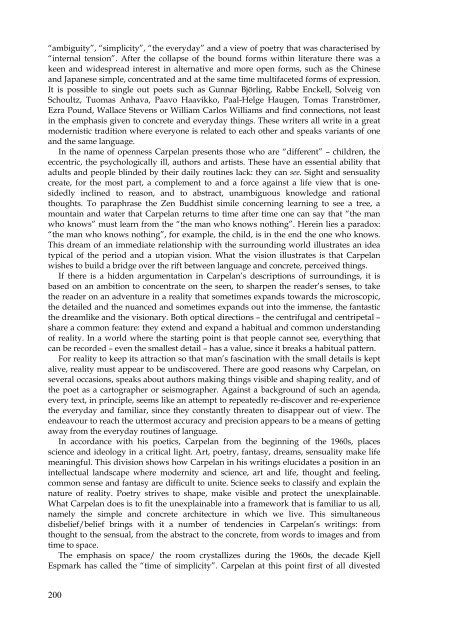You also want an ePaper? Increase the reach of your titles
YUMPU automatically turns print PDFs into web optimized ePapers that Google loves.
“ambiguity”, “simplicity”, “the everyday” and a view of poetry that was characterised by<br />
“internal tension”. After the collapse of the bound forms within literature there was a<br />
keen and widespread interest in alternative and more open forms, such as the Chinese<br />
and Japanese simple, concentrated and at the same time multifaceted forms of expression.<br />
It is possible to single out poets such as Gunnar Björling, Rabbe Enckell, Solveig von<br />
Schoultz, Tuomas Anhava, Paavo Haavikko, Paal-Helge Haugen, Tomas Tranströmer,<br />
Ezra Pound, Wallace Stevens or William Carlos Williams and find connections, not least<br />
in the emphasis given to concrete and everyday things. These writers all write in a great<br />
modernistic tradition where everyone is related to each other and speaks variants of one<br />
and the same language.<br />
In the name of openness Carpelan presents those who are “different” – children, the<br />
eccentric, the psychologically ill, authors and artists. These have an essential ability that<br />
adults and people blinded by their daily routines lack: they can see. Sight and sensuality<br />
create, for the most part, a complement to and a force against a life view that is onesidedly<br />
inclined to reason, and to abstract, unambiguous knowledge and rational<br />
thoughts. To paraphrase the Zen Buddhist simile concerning learning to see a tree, a<br />
mountain and water that Carpelan returns to time after time one can say that “the man<br />
who knows” must learn from the “the man who knows nothing”. Herein lies a paradox:<br />
“the man who knows nothing”, for example, the child, is in the end the one who knows.<br />
This dream of an immediate relationship with the surrounding world illustrates an idea<br />
typical of the period and a utopian vision. What the vision illustrates is that Carpelan<br />
wishes to build a bridge over the rift between language and concrete, perceived things.<br />
If there is a hidden argumentation in Carpelan’s descriptions of surroundings, it is<br />
based on an ambition to concentrate on the seen, to sharpen the reader’s senses, to take<br />
the reader on an adventure in a reality that sometimes expands towards the microscopic,<br />
the detailed and the nuanced and sometimes expands out into the immense, the fantastic<br />
the dreamlike and the visionary. Both optical directions – the centrifugal and centripetal –<br />
share a common feature: they extend and expand a habitual and common understanding<br />
of reality. In a world where the starting point is that people cannot see, everything that<br />
can be recorded – even the smallest detail – has a value, since it breaks a habitual pattern.<br />
For reality to keep its attraction so that man’s fascination with the small details is kept<br />
alive, reality must appear to be undiscovered. There are good reasons why Carpelan, on<br />
several occasions, speaks about authors making things visible and shaping reality, and of<br />
the poet as a cartographer or seismographer. Against a background of such an agenda,<br />
every text, in principle, seems like an attempt to repeatedly re-discover and re-experience<br />
the everyday and familiar, since they constantly threaten to disappear out of view. The<br />
endeavour to reach the uttermost accuracy and precision appears to be a means of getting<br />
away from the everyday routines of language.<br />
In accordance with his poetics, Carpelan from the beginning of the 1960s, places<br />
science and ideology in a critical light. Art, poetry, fantasy, dreams, sensuality make life<br />
meaningful. This division shows how Carpelan in his writings elucidates a position in an<br />
intellectual landscape where modernity and science, art and life, thought and feeling,<br />
common sense and fantasy are difficult to unite. Science seeks to classify and explain the<br />
nature of reality. Poetry strives to shape, make visible and protect the unexplainable.<br />
What Carpelan does is to fit the unexplainable into a framework that is familiar to us all,<br />
namely the simple and concrete architecture in which we live. This simultaneous<br />
disbelief/belief brings with it a number of tendencies in Carpelan’s writings: from<br />
thought to the sensual, from the abstract to the concrete, from words to images and from<br />
time to space.<br />
The emphasis on space/ the room crystallizes during the 1960s, the decade Kjell<br />
Espmark has called the “time of simplicity”. Carpelan at this point first of all divested<br />
200

















